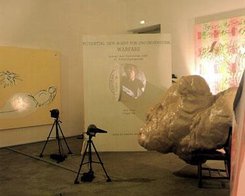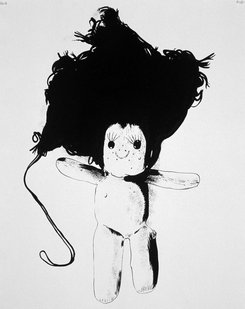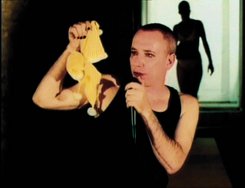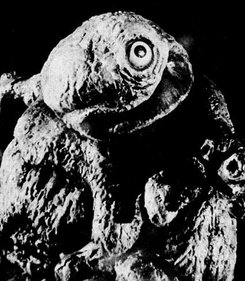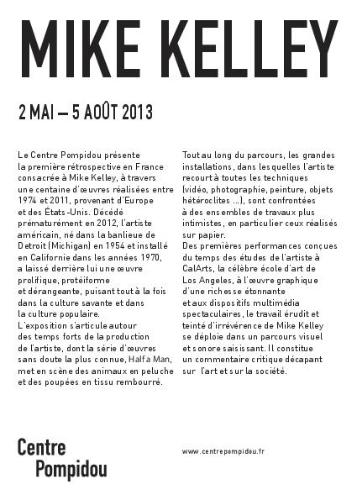Exhibition
Mike Kelley
�2 May - �5 Aug 2013
�2 May - �5 Aug 2013

The event is over

By Sophie Duplaix, Chief Curator of Contemporary Collections, Musée National d'Art Moderne, Exhibition Curator The Centre Pompidou presents the first French retrospective of Mike Kelley's work, featuring around one hundred works produced between 1974 and 2011. On his premature death in January 2012, the American artist (born in 1954 in Detroit) left behind him a prolific and disturbing body of work, which draws on both learned and popular culture. Following its first stop at the Stedelijk Museum in Amsterdam, this touring exhibition, conceived in collaboration with the Mike Kelley Foundation for the Arts, will also be shown at the MoMA PS1 in New York and the MoCA in Los Angeles. The exhibition will be reconfigured for each location. At the Centre Pompidou, the exhibition is built around the highlights of the artist's production. Large installations are contrasted with collections of more intimate works, particularly on paper, from European and American collections. From the first performances by the artist at CalArts, the famous art school in Los Angeles, to his surprisingly rich graphic work and spectacular installation sculptures, for which he uses a huge variety of techniques (video, photographs, motley objects, etc.), Mike Kelley's intellectual, yet also slightly irreverent, work unfolds in a gripping visual and auditory journey. The exhibition opens with his first performances from the second half of the 1970s in which the sound dimension is omnipresent. Mike Kelley uses objects of elementary shapes (tubes, cones, etc.) made from ordinary materials, which act as conveyors, amplifiers or decoders of language. In Plato's Cave, Rothko's Chapel, Lincoln's Profile, Kelley forms verbal associations from names which have a priori nothing in them, to write the script of a performance where he sets the scene in the style of a rock concert. This interest in sound and popular musical culture is also demonstrated by the punk rock group that Mike Kelley founded with Tony Oursler in 1977, The Poetics, whose history, kept private, was put in perspective in a magisterial installation presented initially at the Documenta X in Cassel in 1997 then acquired by the Centre Pompidou. The recovery of “miners'” stories is at the heart of Mike Kelley's work, which repeatedly eludes fixed and linear narratives to reconstruct other networks of references, inviting us to think about things differently. An important section of the exhibition is dedicated to that which made Mike Kelley famous – not without a hint of scandal – at the beginning of the 1990s: the series of works entitled Half a Man. It comprises large drawings of body parts – lungs, intestines, brains, etc. – linked to drawings of rubbish sacks or rag dolls, as well as small knitted rugs placed on the ground, presenting animals in found furs or hand-made stuffed dolls. Mike Kelley creates a dialogue between the psychological and artistic registers, the regressive and the critique of minimalism. What the artist provides is by no means an autobiographical commentary, but an installation that is both tragic and comic, drawing on the world of childhood whilst still addressing adults, generating empathy as much as rejection in a tension which necessarily provokes a certain malaise. Another section is based around the theme of education, featuring in particular Educational Complex, a gigantic white model representing all the schools which have punctuated the life of Mike Kelley. The smooth parts correspond to areas which the memory has not been able to restore, a symptom, according to the artist, of the occurrence of trauma. The issue of repressed memory and the creation of screen memories stimulate a whole segment of his works; from this major work to the installations of the Day is Done corpus, fictions created from images of students' extra-curricular activities, such as masquerade parties or other unusual competitive rituals. The exhibition also gives space to the Memory Ware series which incorporates both scale, with an imposing sculpture of informal contours decorated with trinkets, and two dimensions, with tableaux made from multiple small found objects fixed in the material to compose, in spite of their derisory character, a highly seductive visual world. The extreme registers, both from an artistic and cultural perspective, are repeatedly contrasted with a surprising audacity, as if he wanted to shatter every restrictive hierarchy and view the world, such as it is, in its beauty and ugliness. One room is dedicated to the energies at work in the cosmogony of the artist, spirits which take over beings or vital, sexual, energy. Fluid circulation is one of the recurring motifs in Mike Kelley's iconography. The exhibition ends with a room dedicated to a collection based on the Kandors series, inspired by the mythical city of Superman. Mike Kelley produced multiple representations of the fictional city in innumerable forms, from large light installations to colourful microcosms. This series returns to the issue of memory, where gaps conceal the fidelity of all representation. Kandor has never been similarly portrayed in the comic books, to the extent that it is open to a multitude of versions, all equally valid, which the artist has taken on without attempting to end it. The overlapping of series, their resonance, the use of all materials and all formal registers and the key role of sound and language instil in this masterful body of work the power of a critical commentary on art and society.

By Sophie Duplaix, Chief Curator of Contemporary Collections, Musée National d'Art Moderne, Exhibition Curator
The Centre Pompidou presents the first French retrospective of Mike Kelley's work, featuring around one hundred works produced between 1974 and 2011. On his premature death in January 2012, the American artist (born in 1954 in Detroit) left behind him a prolific and disturbing body of work, which draws on both learned and popular culture. Following its first stop at the Stedelijk Museum in Amsterdam, this touring exhibition, conceived in collaboration with the Mike Kelley Foundation for the Arts, will also be shown at the MoMA PS1 in New York and the MoCA in Los Angeles. The exhibition will be reconfigured for each location.
At the Centre Pompidou, the exhibition is built around the highlights of the artist's production. Large installations are contrasted with collections of more intimate works, particularly on paper, from European and American collections. From the first performances by the artist at CalArts, the famous art school in Los Angeles, to his surprisingly rich graphic work and spectacular installation sculptures, for which he uses a huge variety of techniques (video, photographs, motley objects, etc.), Mike Kelley's intellectual, yet also slightly irreverent, work unfolds in a gripping visual and auditory journey.
The exhibition opens with his first performances from the second half of the 1970s in which the sound dimension is omnipresent. Mike Kelley uses objects of elementary shapes (tubes, cones, etc.) made from ordinary materials, which act as conveyors, amplifiers or decoders of language. In Plato's Cave, Rothko's Chapel, Lincoln's Profile, Kelley forms verbal associations from names which have a priori nothing in them, to write the script of a performance where he sets the scene in the style of a rock concert. This interest in sound and popular musical culture is also demonstrated by the punk rock group that Mike Kelley founded with Tony Oursler in 1977, The Poetics, whose history, kept private, was put in perspective in a magisterial installation presented initially at the Documenta X in Cassel in 1997 then acquired by the Centre Pompidou.
The recovery of “miners'” stories is at the heart of Mike Kelley's work, which repeatedly eludes fixed and linear narratives to reconstruct other networks of references, inviting us to think about things differently. An important section of the exhibition is dedicated to that which made Mike Kelley famous – not without a hint of scandal – at the beginning of the 1990s: the series of works entitled Half a Man. It comprises large drawings of body parts – lungs, intestines, brains, etc. – linked to drawings of rubbish sacks or rag dolls, as well as small knitted rugs placed on the ground, presenting animals in found furs or hand-made stuffed dolls. Mike Kelley creates a dialogue between the psychological and artistic registers, the regressive and the critique of minimalism. What the artist provides is by no means an autobiographical commentary, but an installation that is both tragic and comic, drawing on the world of childhood whilst still addressing adults, generating empathy as much as rejection in a tension which necessarily provokes a certain malaise.
Another section is based around the theme of education, featuring in particular Educational Complex, a gigantic white model representing all the schools which have punctuated the life of Mike Kelley. The smooth parts correspond to areas which the memory has not been able to restore, a symptom, according to the artist, of the occurrence of trauma. The issue of repressed memory and the creation of screen memories stimulate a whole segment of his works; from this major work to the installations of the Day is Done corpus, fictions created from images of students' extra-curricular activities, such as masquerade parties or other unusual competitive rituals. The exhibition also gives space to the Memory Ware series which incorporates both scale, with an imposing sculpture of informal contours decorated with trinkets, and two dimensions, with tableaux made from multiple small found objects fixed in the material to compose, in spite of their derisory character, a highly seductive visual world. The extreme registers, both from an artistic and cultural perspective, are repeatedly contrasted with a surprising audacity, as if he wanted to shatter every restrictive hierarchy and view the world, such as it is, in its beauty and ugliness. One room is dedicated to the energies at work in the cosmogony of the artist, spirits which take over beings or vital, sexual, energy. Fluid circulation is one of the recurring motifs in Mike Kelley's iconography.
The exhibition ends with a room dedicated to a collection based on the Kandors series, inspired by the mythical city of Superman. Mike Kelley produced multiple representations of the fictional city in innumerable forms, from large light installations to colourful microcosms. This series returns to the issue of memory, where gaps conceal the fidelity of all representation. Kandor has never been similarly portrayed in the comic books, to the extent that it is open to a multitude of versions, all equally valid, which the artist has taken on without attempting to end it. The overlapping of series, their resonance, the use of all materials and all formal registers and the key role of sound and language instil in this masterful body of work the power of a critical commentary on art and society.
Where
Galerie sud
When
�2 May - �5 Aug 2013
11am - 9pm, every days except tuesdays